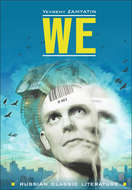Kitobni o'qish: «The Amphibian / Человек-амфибия. Книга для чтения на английском языке»
© КАРО, 2018
From the Publishers
The Amphibian will throw you back to a time when skin and deep-sea diving had not yet made the Silent World begin yielding up its secrets on a really big scale, as aqualung and snorkel are doing today, and present to you Alexander Belyaev’s 1928 prevision of the ocean mastered by mankind.
Sea-devil has appeared in the Rio de la Plata. Weird cries out at sea, slashed fishermen’s nets, glimpses of a most queer creature astride a dolphin leave no room for doubt. The Spaniard Zurita, greed overcoming his superstition, tries to catch Sea-devil and force it to pearl-dive for him but fails.
On a lonely stretch of shore, not far from Buenos Aires, Dr. Salvator lives in seclusion behind a high wall, whose steel-plated gates only open to let in his Indian patients. The Indians revere him as a god but Zurita has a hunch that the god on land and the devil in the sea have something in common. Enlisting the help of two wily Araucanian brothers he sets out to probe the mystery.
As action shifts from the bottom of the sea to the Spaniard’s schooner The Jellyfish and back again, with interludes in sun-drenched Buenos Aires and the countryside, the mystery of Ichthyander the sea-devil is unfolded before the reader in a narrative as gripping as it is informative.
Alexander Belyaev, the first-and very nearly the best-Soviet science-fiction writer, was born in 1884 in Smolensk. When a little boy Alexander was full of ideas. One of them was to fly. And he did fly – from a rooftop – until one day he fractured his spine. This was put right, but at the age of 32 he developed bone tuberculosis and was bed-ridden for nearly six years and later for shorter stretches.
After school he studied law and music. To pay for his tuition he played in an orchestra, designed stage settings and did free lance journalism, which he continued after graduation. In 1925 he gave up law and devoted himself wholly to writing.
His first novel, Professor Dowell’s Head, serialized in a popular magazine in 1926, was an immediate success. Since then A. Belyaev wrote fifty-odd novels – many of them as topical as if written today – reaching the one-million copy mark by January 1942 when he died near Leningrad (now St. Petersburg). His best known books are The Amphibian, A Jump into Nothingness and The Island of Dead Ships.
Part I
“The Sea-Devil”
The close night of the Argentine midsummer came down on the sea. Stars pricked out in a sky that was a deep violet. The schooner Jellyfish lay quietly at anchor, with not a splash round her, not a creak on board. Ship and ocean seemed in deep slumber.
Half-naked pearl-divers sprawled on the deck. Worn out by the day’s work under a parching sun they tossed and groaned and cried out in their nightmarish sleep. Their limbs would jerk and twitch; perhaps they were fighting off sharks – their deadly enemies. The hot windless weather of which they were having a spell made people so tired that they couldn’t even hoist the boats on board at the end of a day’s work. Not that it seemed necessary: nothing indicated a change in weather. So the boats were left afloat, made fast to the anchor chain. Nobody had thought of tightening the shrouds or sheeting home the jib which fluttered faintly at each stray whiff of wind. From bowsprit to taffrail the schooner was strewn with heaps of pearl shells, pieces of coral, lengths of diving cord, canvas sacks for putting shells in and empty barrels.
Against the mizzen-mast stood a big water barrel with an iron mug on a chain. The deck immediately round was stained dark with spilt water.
Every now and then a diver struggled up and staggered along, sleep-drunk, to the water barrel. Never opening his eyes he swallowed a mugful and dropped down anywhere on his way back, as if it were not water he had drunk but neat spirit. The divers were always thirsty. They went without morning meals, for underwater pressure made diving on a full stomach dangerous, so they worked without eating all through the day, till it grew too dark underwater. They had their meal before turning in-and that was of salt meat.
The Indian Baltasar, right hand of the schooner’s owner Pedro Zurita, had the night watch.
In his time Baltasar had been known far and wide as an excellent pearl-diver. He could stay underwater for as much as a minute and a half or even two minutes which was about twice as long as an average diver.
“How did we do it? They knew how to train in my day and started early,” Baltasar would say to the young divers.
“Just turned ten I was. My father took me to Jose, who owned a tender, for training. There were twelve of us, all kids like me. And this is the way he trained us. He’d throw a white pebble or shell into the water and order one of us to go and get it. And each time he found deeper and deeper places. If one of us had nothing to show for his diving Jose’d give him a lash or two of his whip and shove Mm overboard to try again. And it worked. Then he started to train us to keep longer times underwater. An experienced diver’d go down and make a basket or piece of netting fast to the anchor chain. Then down we went to untie the knots. And we weren’t allowed to come up before all the knots were undone. If we did we got the whip again.
“The amount of beating we took! Not everybody could stick it out. But it made a diver out of me-and the best in the district. And earned me a pretty penny too.”
Then the time had come when Baltasar had to give up the hazardous trade of a pearl-diver. He was no longer young and his left leg bore the terrible scars of a shark’s teeth and his side the marks of an anchor chain. He bought a small shop in Buenos Aires and started a trade in pearls, corals, shells and sea curios. But shore life bored him and once in a while he decided he needed a break and put out to sea with pearl-divers.
He was always sure of a welcome, for what he didn’t know about the Rio de la Plata and its pearling grounds was just not worth knowing. He was welcomed by all-he knew how to please divers and owners alike. The young divers he taught the tricks of the trade: how to hold their breath underwater and to fight off sharks, and-when in specially expansive mood-how to keep an extra fine pearl out of the boss’s sight.
The owners he helped to sort out pearls and evaluate the best.
Baltasar was sitting on an upturned barrel, a thick cigar between his fingers, his face picked out of the darkness by the light of a lantern fixed to the mast. It was an elongated face with a finely cut nose and large handsome eyes – the face of an Araucanian. He was drowsing. But even when his eyes were asleep, his ears were not. They registered sounds and gave him warning in the deepest of sleep. There was nothing but the divers’ sighing and murmuring to hear. The smell of rotting pearl oysters wafted from offshore. It was part of the job: the shell of a dead mollusc opens more easily. What would have been an overpowering stench for an unaccustomed nose was near perfume for Baltasar’s. For him, a sea tramp that he was it meant all the pleasures and dangers of life at sea.
After the last pearl was extracted the largest shells were brought on board the Jellyfish. Zurita wasn’t one to let anything go to waste. He sold the shells to a factory where they made buttons and studs out of them.
* * *
Baltasar was asleep. The cigar had slipped from between his fingers. His chin rested on his chest.
A sound from far out at sea broke in on his sleep. Then it came nearer. Baltasar opened his eyes. What seemed to him the blast of a horn sounded again, followed by the cheerful ring of a young voice, repeated after an interval in a higher pitch.
The blast of the horn bore no resemblance to the harsh blare of ship’s siren, nor the cheerful voice to the cries of a man, fallen overboard. In fact it didn’t sound like anything Baltasar could think of. He rose. His sleep seemed blown away by a breeze. He went up to the rail and peered into darkness. His eye and ear detected nothing. Baltasar prodded with his foot a sleeping Indian into wakefulness.
“I heard a cry. That must be him,” he told the diver softly.
“I can’t hear a thing,” the Gurona Indian, now up on his knees and listening, said as softly. Suddenly the horn and voice pierced the heavy silence again.
The Gurona shrank as from a whip lash.
“Yes, that’s him,” he said through his clattering teeth.
Other divers were waking up. They crawled towards the blotch of lantern light as though seeking in the yellowish beam protection from dreadful darkness. There they squatted, huddling together and straining their ears. The horn and voice came from far off again and was heard no more.
“That’s him-the ‘sea-devil’,” the divers were whispering.
“We ought to be clearing out of here.”
“A shark’s a kitten compared to him! “
“Let’s speak to the boss.”
There was a patter of bare feet. Yawning and scratching a hairy chest Pedro Zurita came on deck. A pair of canvas trousers was all he had on; a revolver holster dangled from a broad leather belt. Zurita approached the divers. The lantern light revealed a swarthy face, crumpled with sleep, curls of thick hair escaping onto the forehead, black eyebrows, a pointed moustache and greying goatee.
“What’s up?”
His self-assured voice and deliberate movements calmed the divers.
They spoke all at once.
Baltasar raised a hand to silence them.
“We’ve heard him-the ‘sea-devil’,” he said when order was termporarily restored.
“You dreamt it,” Pedro said sleepily.
“We didn’t. We all heard his horn,” shouted the divers.
Again Baltasar waved them to silence.
“I heard the horn myself. That was him all right. There’s nobody at sea can blow a horn like that. We ought to be getting away from here, and lose no time about it.”
“Old wives’ tales,” said Pedro Zurita. He didn’t like the idea of sailing from the pearling ground with all those oysters on board, stinking and still not ready for opening. But it was like running his head against a stone wall, trying to talk the divers into staying. They shouted discordantly, flung their arms about and threatened to abandon the schooner and walk to Buenos Aires if Zurita didn’t weigh anchor.
“Curse you and the ‘sea-devil’,” he said finally. “You win. Well weigh anchor at dawn.” And grumbling and cursing he went below.
He was no longer sleepy. Lighting the lamp he got a cigar going and began pacing up and down his small cabin. His thoughts turned to the mysterious creature that had been haunting their part of the estuary for some time now, striking terror into the fishermen and seaside villagers.
Sailors and fishermen would tell tales about it, with many a timid glance over the shoulder, as if afraid that the monster might surprise them even as they spoke about it.
The creature was believed to have helped some people and harmed others.
“It’s the sea-god,” said the older Indians, “him as comes out of the ocean once in a thousand years – to restore justice on earth.”
The Catholic priests exhorted their superstitious Spanish flock to seek salvation in religion, saying that the sea-monster was a visitation of the wrath of God for their neglect of the Holy Catholic Church.
Rumours spread and at last reached Buenos Aires. For weeks the “sea-devil” made headlines in the sensation-hungry press. Any unaccounted-for loss of schooner or fishing-craft, any theft of nets or fish catch were all the “sea-devil’s” doing. But there were other stories as well-of big fish mysteriously deposited in fishing boats, of men saved from drowning.
At least one of these swore that when he was going under for the last time somebody caught him from behind and sped him shorewards and onto the beach, disappearing behind the surf the very moment he struggled to his feet and looked back.
Nobody had seen the “sea-devil” or rather nobody was credited with having seen it. Though, of course, there were some who called heaven to witness that the creature had a head adorned with horns and a goat’s beard, the legs of a lion and the tail of a fish or described it as an enormous toad with legs shaped like a man’s.
At first the authorities paid no attention to all these rumours and newspaper articles, hoping for the sensation to fizzle out as newspaper sensations do. But rumours led to apprehension and apprehension to alarm, especially among the fishermen. They were afraid to put out to sea; catches declined; Buenos Aires was experiencing a shortage of fish. The authorities decided it was time to intervene. A force of coastguard cutters and police launches was mustered and given orders “to detain a person of unknown identity that is causing alarm and panic among the seaside population.”
* * *
For a fortnight the task force combed the Rio de la Plata and the coast with nothing to their credit but several Indians detained for spreading rumours likely to cause alarm and panic.
The chief of the police issued an official announcement to the effect that the “devil” only existed in the rumours spread by some ignorant people, already detained and about to receive the punishment they deserved, and admonished the fishermen to scorn the rumours spread and resume their useful trade.
This helped for a time, but not for long: soon the “devil” was up to new pranks.
Some fishermen were wakened in the dead of night by the bleating of a kid that nothing short of magic could have put into their boat, lying as she was a goodish way offshore. Other fishermen hauled in their nets to find them slashed to pieces.
Overjoyed by the reappearance of the “devil” the newspapers now clamoured for the opinion of science. Nor had they to wait for long.
Scientists claimed that a sea-monster capable of intelligent acts could not exist in that part of the ocean unknown to science. They went on to say that this did not necessarily apply to greater ocean depths, though even there they would not expect to find such a monster. They tended to agree with the off-the-record opinion of the chief of the police who thought that some practical joker was at the bottom of it all.
But not all scientists shared that opinion. Some referred in their arguments to Konrad Hessner, world-famous naturalist, who left us descriptions of the sea-maiden, sea-devil, sea-monk and sea-bishop.
“When all is said and done many of the things propounded by ancient and medieval scientists have been borne out in our times for all modern science’s endeavours to ridicule them out of existence. Divine creation is truly inexhaustible and we scientists, more than anybody else, are called upon to practise modesty and caution in our conclusions,” they wrote.
These last apparently believed more in religion than in science and their lectures were more like homilies.
Finally a scientific expedition was equipped and dispatched to settle the scholarly wrangle.
The members of the expedition found no “devil” but they learned a great deal about the “unknown person’s” goings (the older members insisted that the word “person” be changed for the word “creature”).
The newspapers carried the expedition’s report, which said;
“1. In several places on the beaches we examined we found narrow footprints of a distinct human shape. Though leading from and back to the sea, they might have been made by people from boats.
“2. The nets we examined had cuts of the type produced by sharp instruments.
They might have been caught on sharp underwater crags or twisted metalwork of wrecks.
“3. A report – brought to our attention-of a dolphin that had been carried by a storm ashore, well clear of the water, and dragged back into the sea by someone who had left behind what looked like clawed footprints, has been carefully looked into.
“We are fully satisfied that the dolphin in question had been restored to its element by some kindhearted fisherman. Nor would this have been the only instance of kindness on the part of fishermen towards dolphins. It is common knowledge that dolphins in pursuit of fish sometimes help the fishermen in that they drive fish to the shallows inshore. The alleged claws of the footprints could have been the work of the witnesses’ imagination.
“4. The kid might have been brought by boat and slipped on board by some practical joker.”
The scientists had a lot more to say in their attempts to explain away the “devil’s doings”. They were convinced that no sea creature could have performed them.
But the scientists’ explanations did not satisfy everybody. They seemed insufficient even for some of the scientists. How could a practical joker-however resourceful and clever-keep dark his identity for so long? Yet what made the whole thing really baffling was that according to the expedition’s findings-incidentally not included in their report-the “devil” sometimes performed several tricks of his at short intervals in places situated very widely apart. Either the “devil” could travel at an unheard-of speed or there were several of them at work. And that made the practical joker idea altogether too thick to believe.
That was what went through Zurita’s mind as he paced up and down his cabin.
Dawn had come unnoticed and with it a pink beam of light, stealing through the port-hole. Pedro put out the lamp and started washing.
As he poured the tepid water over his head he heard cries of alarm coming from deck. Halfwashed, he hurried up the companion ladder.
Pressing to the rail on the seaward side of the schooner the divers in loin-cloths were gesticulating amid a tumult of voices. Pedro looked down. There were no boats where they had been the previous night. Apparently they had gone adrift somehow in the night off-shore breeze. Now the morning breeze was slowly bringing them shorewards. Their oars were afloat, scattered all over the bay.
Zurita ordered the divers to collect the boats. Nobody budged. Zurita repeated his order.
“Why don’t you go and try your own luck with the ‘devil’?” somebody said.
Zurita placed a hand on his holster. The divers fell back against the mast, glowering at Zurita. A showdown seemed inevitable. Then Baltasar stepped into the breach.
“There isn’t a thing will scare an Araucanian,” he said. “A shark didn’t fancy my old bones, neither will the ‘sea-devil’.” Lifting his arms he took a dive and swam towards the boats. The divers pressed to the rail again, watching Baltasar’s progress with alarm. Handicapped though he was by age and an injured leg, he swam like a fish. A few powerful strokes brought the Indian alongside a boat. Picking up a floating oar he climbed into the boat.
“The painter’s cut with a knife,” he shouted. “Clean work-couldn’t have been done better with a razor.”
Seeing Baltasar safe and sound some of the divers followed suit.
Riding a Dolphin
Though only just risen the sun was scorchingly hot. There was not a cloud in the sky, not a ripple on the sea. The Jellyfish was a dozen miles or so south of Buenos Aires when, following Baltasar’s advice, anchor was dropped in a small bay near a shore that rose in two rocky ledges straight from the water.
The boats scattered all over the bay. Each was manned by two divers, who did the diving and the hauling in turns.
The diver in the boat closest inshore seized a big piece of coral that was tied to the diving cord between his legs and made swiftly for the sea-bed.
The water was warm and so transparent that you could count the pebbles on the sea-bed. Closer inshore corals rose up like so many bushes of a petrified submarine garden. Small silver-bodied fish flashed in and out among the bushes.
The diver crouched on the sea-bed, quickly picking shells and putting them into the small bag hooked to his leather belt. His tender, a Gurona Indian, his head and shoulders bent over the gunwale for a better view of the diver, held to his end of the diving cord.
Suddenly he saw the diver leap up, snatch at the cord and give it a sharp tug that nearly pulled the Gurona overboard. The boat rocked. The Indian hurried hand over hand with the cord. Presently he was helping the heavily breathing man into the boat. His pupils were dilated, his dusky face ashen.
“Was it a shark?”
But the diver had not recovered sufficient wind to answer.
What could have scared him so badly? The Gurona bent low to the water surface for a better look. Something was definitely wrong down there. The small fry-like birds spotting a falcon-were speeding to the safety of submarine forest thickets.
Then he saw what looked like a cloud of purplish smoke billow into view from behind a submarine rock. As the cloud grew bigger the water turned a pinkish tint. Then a dark shape half-appeared from behind the rock, made a slow turn and slid back. That was a shark and the purplish cloud-blood spilt on the seabed. What could have happened down there? The Gurona looked at his mate. But he couldn’t provide the answer. Lying on his back, he was snatching air with wide-open mouth, staring with unseeing eyes into the skies. There was nothing for it but to take him straight to the Jellyfish.
All the divers that were on board clustered round the man.
“Speak up, man,” said a young Indian, shaking the diver. “Afraid your funky soul will part company with your body, if you open your mouth, eh?”
The diver shook his head, slowly recovering.
“I saw the ‘sea-devil’,” he said in a hollow faltering voice.
“The ‘sea-devil’?”
“Come on then, for Christ’s sake, tell us about him,” the divers shouted impatiently.
“I looked up and saw a shark. Making straight for me. A big black brute with its huge jaws ready to snap. It sure seemed I’d had it. Then I saw him – ”
“The ‘devil’?”
“What does he look like? Has he got a head?”
“A head? Think he has. Eyes as big as saucers.”
“If he has eyes he must have a head,” was the young Indian’s verdict. “Eyes don’t come all by themselves. Any legs?”
“He’s got front legs-like a frog’s. Long green fingers, webbed and with daws. And he’s all ablaze like a fish with scales. He makes for the shark, flashes with a front leg. Swish! There’s a fountain of blood-”
“What do his hind legs look like?” a diver interrupted him.
“Hind legs?” He tried to remember. “There’s no hind legs. Just a big tail-ending in two snakes.”
“Who gave you the worst scare, him or the shark?”
“The monster! “ came the unhesitating answer. “For all it saved my life.”
“The ‘sea-devil’,” said an Indian.
“The sea-god that helps the poor,” an old Indian corrected him.
By this time the news had reached the farthest boats and more and more divers were coming on board, eager for the story.
The man was made to repeat his story over and over again. As he did so he recalled more details. It now appeared that the monster breathed fire and wriggled its ears, had sabre-like teeth, large fins and a tail like a rudder.
White-trousered and sombreroed Pedro Zurita shuffled back and forth in the background, his bare feet thrust into a pair of sandals, taking note of what was being said.
The more the diver recovered the use of his tongue the more Pedro became convinced that it was all a shark-scared diver’s imagination. And yet it can’t be only that, he thought. Somebody did slit that shark’s side open-with all that pinkish water in the bay. The Indian’s lying but there’s obviously more to it than meets the eyes. Rum business, dammit, he thought.
At that moment Zurita’s train of thought was cut short by the blow of a horn coming from the direction of the reefs.
It had the effect of a thunderbolt. Tongues were paralyzed. Faces turned ashen-grey. Horror-stricken eyes stared in the direction of the reefs.
Near the reefs a family of dolphins were frisking in the water. One of the dolphins gave a loud snort as if in response to the horn summons, made for the reefs and was soon lost to sight behind them. After a few tense moments it reappeared. Riding it was the oddest creature, in fact, the very “sea-devil” just described by (he diver. The monster had the body and head of a man, with a pair of immense eyes that blazed in the sun like a car’s headlights; silvery-blue skin and dark-green forelegs, long-fingered and webbed. The creature’s legs were immersed in the water, so there was no telling whether they were of man or of beast. In one of its forelegs the creature had a long winding shell. Giving another blow on it the creature laughed a gay manly laugh and suddenly shouted: “Full speed ahead, Leading! “ in perfect Spanish, patted the dolphin’s glossy back with its frog’s hand and spurred its mount with its legs. And like a well-broken horse the dolphin put on speed.
A cry of surprise escaped the divers.
The creature looked round. The next they knew it was off the dolphin and on the other side of it. A green foreleg shot into sight to slap the dolphin’s back. Obedient to it the mount submerged.
The odd pair could just be seen making a quick half-circle and then it disappeared behind the reefs.
The whole thing had taken not more than a minute but the lookers-on stood rooted to the spot for some time.
Then hell broke loose. Some of the Indians shouted and ran about as though demented, others fell on their knees and prayed to God to spare their lives. A young Mexican, bawling with fright, took refuge high up the main mast. The Blacks crept below into the hold.
There could be no question of going on with the work. It was all Pedro and Bal-tasar. could do to restore some order. The Jellyfish weighed anchor and sailed due north.








